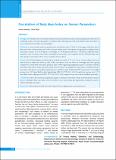Please use this identifier to cite or link to this item:
https://hdl.handle.net/20.500.14356/1223| Title: | Correlation of Body Mass Index on Semen Parameters |
| Authors: | Maskey, Suvana Rijal, Hima |
| Citation: | MaskeyS., & RijalH. (2022). Correlation of Body Mass Index on Semen Parameters. Journal of Nepal Health Research Council, 19(04), 838-843. https://doi.org/10.33314/jnhrc.v19i04.3919 |
| Issue Date: | 2021 |
| Publisher: | Nepal Health Research Council |
| Article Type: | Original Article |
| Keywords: | Asthenospermia body mass index hypovolemeia oligospermia semen parameters |
| Series/Report no.: | Oct-Dec, 2021;3919 |
| Abstract: | Abstract Background: Studies done to determine relation of increase in Body mass index and semen parameters have shown conflicting results, some showing negative correlation others showing none. This study aimed to find out if there is any association between them in our population. Methods: A cross-sectional study was performed in an infertility clinic in 2018/19 reviewing records from which Body mass index of male partner and results of semen analysis noted. Participants were grouped according to Body mass index; normal: 18.5–24.99 kg/m2, overweight: 25–29.99 kg/m2 and obese: >30 kg/m2. Different semen parameters such as volume, total count, concentration and motility were compared between different Body mass index groups to determine if there is any association between them. Results: Total 249 participants enrolled with mean Body mass index of 25.1 + 3.4 years. Semen volume decreased with increase in Body mass index (p value 0.063) and sperm count was lower in overweight and obese group compared to normal Body mass index group (p value 0.449) suggesting insignificant negative correlation of Body mass index with semen volume and sperm count. However there was insignificant weak positive correlation of Body mass index with sperm concentration and progressive motility (p value 0.668 and 0.973 respectively). Overweight persons were 3.14 times likely to have hypovolemia (OR:3.14; 95%CI: 1.51-6.53) and obese persons were 1.19 times likely to have oligospermia (OR:1.19 95% CI: 0.42-3.36) compared to persons with normal Body mass index. Conclusions: Body mass index has insignificant negative correlation with semen volume and total sperm count and persons with higher Body mass index were more likely to have hypovolemia and oligospermia compared to person with normal Body mass index. Keywords: Asthenospermia; body mass index; hypovolemeia; oligospermia; semen parameters. |
| Description: | Original Article |
| URI: | http://103.69.126.140:8080/handle/20.500.14356/1223 |
| ISSN: | Print ISSN: 1727-5482; Online ISSN: 1999-6217 |
| Appears in Collections: | Vol. 19 No. 04 (2021): Vol 19 No 4 Issue 53 Oct-Dec 2021 |
Files in This Item:
| File | Description | Size | Format | |
|---|---|---|---|---|
| 3919-Manuscript-26806-1-10-20220313.pdf | Fulltext Download | 348.4 kB | Adobe PDF |  View/Open |
Items in DSpace are protected by copyright, with all rights reserved, unless otherwise indicated.
